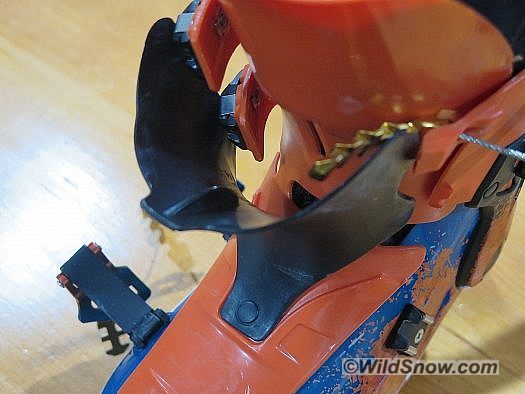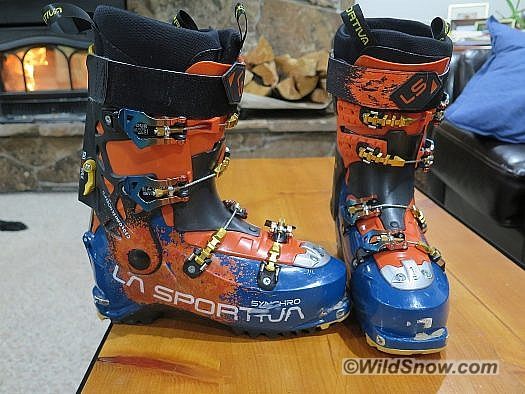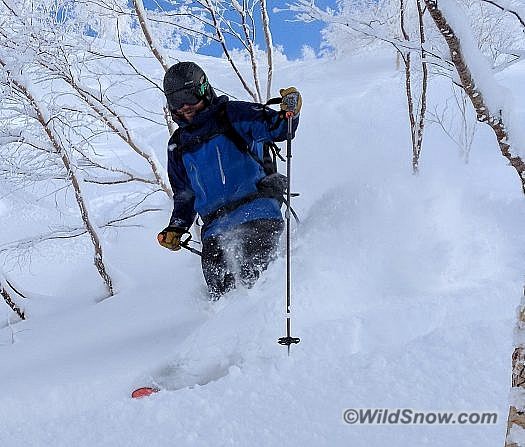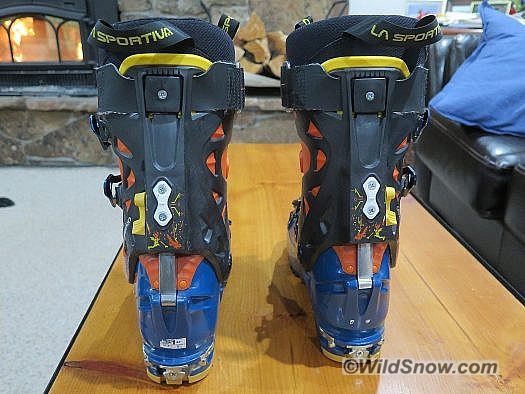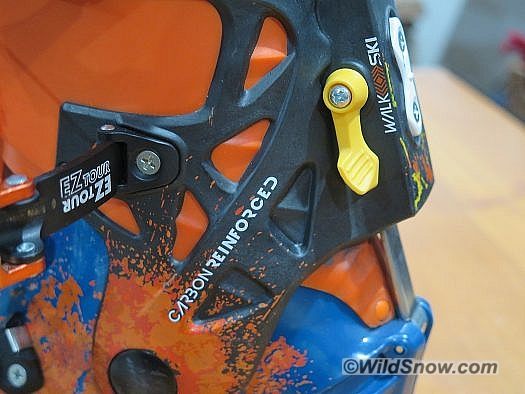Colby Christoff
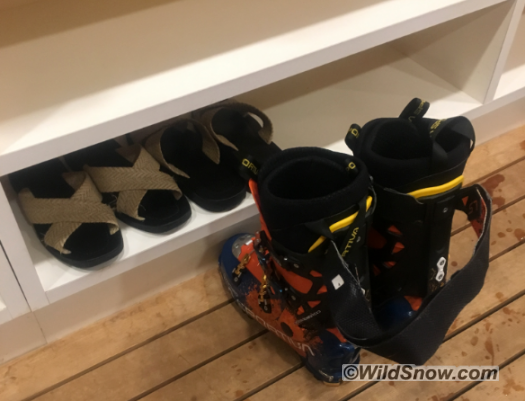
After a tough day of skiing waist deep powder, sometimes you have to walk right into the onsen (hot spring) with your boots on.
My first impressions of the new La Sportiva Synchro boot are for the most part positive. (Also see our previous Synchro coverage.)
— For a “125 flex” the boot seemed light.
— The “catalog” range of motion claimed by La Sportiva website is 60 degrees. I find the more flex I have in my boots, the less heel risers I typically need on my bindings. I found this to be true in the boot; I was pleased with the range of motion.
— The 102 mm last provides a wider foot with plenty of room. At first I thought I had too much room, but the buckles allow you to snug up the fit while maintaining performance.
And then, a few longer term observations:
With the very slow start to the Colorado winter season, and subsequently thin snowpack, I found myself constrained to the ski resorts and small backcountry outings for the first part of my Synchro testing (prior to our recent dumps). Luckily, a Japan trip in January put an end to that and provided a very legitimate trial to authenticate this review — and I’ve been skiing the boots ever since.
The feature that stands out to me with this boot is the intermediate cuff. The intermediate cuff is the small black cuff that goes underneath the bottom three buckles. When you skin, you can leave all buckets hooked (theoretically, more on this later) and simply leave the 2nd buckle (from the top) open. By leaving that buckle open the small intermediate cuff is left disengaged, and therefore provides a wider range of motion. And, to be clear, by disengaged I mean there is there is a small “fin” in the back of the black cuff and a small slit in the larger orange tongue. When the two line up, and thus engage, the boot greatly hardens in flex, and when left disengaged the flexibility greatly increases. I thought this was a pretty slick system and was very happy with the range of motion.
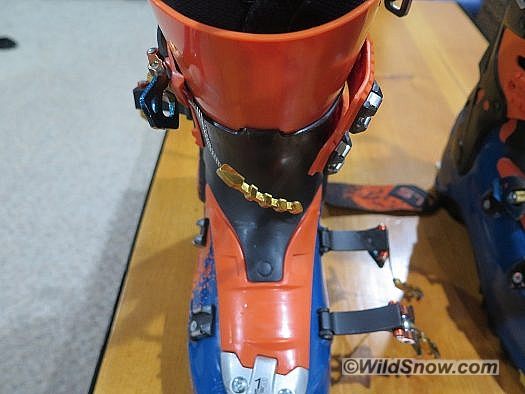
Outer tongue nests on the full length inner tongue, locking the two together when buckled for the down.
I was not particularly fond of the Synchro “Pegasus Plus” buckles. I would often find that they would be flopping around after ten minutes of skinning. Then, when I’d tighten them down to ski and I’d reach the bottom, when releasing the buckles I’d find they would often get hung up on their receiving end, and wouldn’t completely unbuckle. This resulted in time spent tightening the buckle above or below, or tightening the power strap, in order to then release the buckle. This is not a fatal flow; however, it is certainly irritating as you are trying to get out of your boots.
Since the buckles are apt to jiggle around and come undone as you skin, I found that the buckles would sometimes lose their positioning and I would have to re-tighten or loosen their position. This is done by spinning the small “screw” feature clockwise or counterclockwise, similar to the “barrel” adjustment on some bicycle brakes. I understand the intent of all this is to keep the buckles very light, as four do add up in weight. After looking at the La Sportive boots from years past, and having friends with older models of the same boot, the newer type buckles do seem to be an improvement, but may still need some further refinement. With that said, after a long day skiing and touring, and after you are able to release the buckles, I was very pleased to see how far the tongue opens and moves out of the way for a boot that is incredible easy to get on and off.
Now, moving on to the downhill performance, the skiing! In a word, excellent. I used the boots to drive my Blizzard Zero G 95’s 185, Voile V8’s 185, and Liberty Schuster Pro S’s 192 (123 underfoot). I bring up the different skis because an alpine touring boot needs to be versatile, and although it would be nice to have the one ski quiver, we all seem to have too many skis for too many applications. But hey, who can blame you for having too many skis?
While using the Synchro with the Zero Gs we had rock hard ski runs with death cookies, ruts, rocks, and a little powder. I was thus able to experience a little bit of all conditions. When I pressured the tongues, they would drive the skis, when I would hit something choppy, uneven, or lose, they would give confidence that you would power through.
A couple weeks after getting the boots I was invited on a trip to Japan with some friends whom I ski raced with in college. I decided this was the perfect trip for the Synchros.
We traveled to the North Island in Japan, Hokkaido. While there we skied some resort days, while dropping out some of their backcountry gates. The snow in Japan was incredible; I had brought the Synchos along with the Schuster Pro S’s and the Voile V8’s. The Voile’s are quite light for their size; the Synchros skied those exceptionally through the powder. The real test was the heavy, stiffer Liberty’s. I skied the resort one day with the Synchros and throughout the day found untracked powder behind some of the backcountry gates. Although this was primarily untouched pow, there were still tight bumps, trees, and choppy snow. I was able to power through everything with no issues from the boots, or the skis.
I’ve often skied alpine touring boots that were easily overpowered, creating a feeling that you are going to go over the front of the skis. The cuff height and “stiff” flex of La Sportivas held me in place, and gave me confidence to open it up without being worried that the boots wouldn’t push back. I put “stiff” in quotes because I have skied many 150 flex plug boots, so stiff can be a relative term. For the Syncros’s class of boots I was very happy with their skiing performance and their ease of skinning.
The boots clipped in easily to a variety of bindings I used. From an older pair of Dynafit Vertical FT 12 bindings to a brand new set of G3 Ion LT 12’s, and the Tyrolia Adrenalin bindings too, the Synchro locked in with confidence. The tech fittings were easy to line up and clip into the Dynafit and G3 bindings, and the rubber Vibram sole of the boot, though thick, doesn’t compromise the “DIN” shape of the sole. Test for the latter, I was able to easily adjust my Tyrolia bindings for the boot.
Inevitably, each year there are more and more boots on the market with more and more features. It seems many boot companies try to differentiate themselves in one way or another. Perhaps that’s why La Sportiva switched the usual direction of the walk mode versus ski mode setting. As you can see from the photo, walk mode is down and ski mode is up. I believe with most AT boots on the market, ski mode is down and walk mode up. It seems odd to have switched this. I cannot say I had trouble engaging the feature nor is it confusing as to which mode you are in; however, it is odd to make this opposite of most other boots on the market.
Conclusion: The Synchro did well for me, and I’m continuing long term testing for WildSnow. My two gripes with the product are small in the overall scope. Mainly, the buckles could be better and I think we’ll see improvements to the Pegusus concept as La Sportiva progresses this project. Overall, they have designed a well thought out boot that is light and goes uphill well, while supporting strong downhill skiing.
Weights, 27.5 Synchro, BSL 304
Shell, 1244 grams
Liner, 246 grams
Boot complete, 52.6 ounces, 1,490 grams (1550 grams catalog weight)
Compare to Spectre at 51.8 ounces, 1470 (1445 grams catalog weight)
(WildSnow guest blogger Colby Christoff ski raced at Syracuse University. He moved to Colorado some time ago and explores the backcountry whenever he can escape from his job as an engineer. He appears to escape often.)
Beyond our regular guest bloggers who have their own profiles, some of our one-timers end up being categorized under this generic profile. Once they do a few posts, we build a category. In any case, we sure appreciate ALL the WildSnow guest bloggers!

